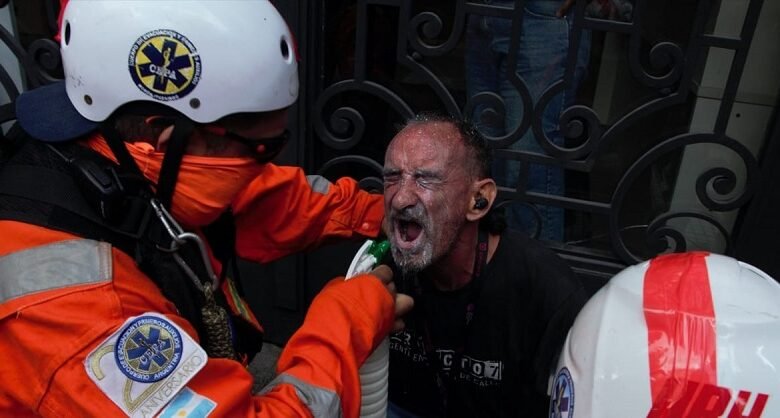

Yesterday, as part of the weekly protests, a new march by retirees took place in Buenos Aires. However, this demonstration was very different from the previous ones, as it unleashed a series of violent incidents that marked a turning point in the political and social situation in Argentina.
By Maira Palavecino
maipalinfo@gmail.com
Even before the rally officially began, the demonstration was harshly repressed by security forces, and the tension also spilled over into Congress, where clashes between deputies became more visible than ever.
The day of protests began with a heavy police presence around the Casa Rosada starting at 6:00 PM, with the National Gendarmerie and other security forces deployed to prevent access to the headquarters of the executive branch.
This siege was part of a growing wave of repression directed not only against the protesters, but also against the soccer fans who went to the protests to defend the “older” and particularly against the retirees, who were also at the center of the mobilization.
Meanwhile, inside Congress, the situation was no less tense. Representatives from the La Libertad Avanza (LLA) bloc engaged in physical confrontations on the premises.
Verbal and physical clashes between legislators, such as the one between Oscar Zago and Lisandro Almirón, are a reflection of the deep divisions within this bloc.
The internal crisis within the LLA became even more evident when Representatives Lilia Lemoine and Marcela Pagano intensified the confrontation. Lemoine attempted to challenge Pagano to leave the chamber, intending to prevent the quorum necessary to reactivate the Impeachment Commission from being reached.
This atmosphere of political chaos deepened with the intervention of Representative Leila Chaher, who accused the Speaker of the Lower House, Martín Menem, of allowing violence to take over Congress. According to Chaher, Menem not only failed to stop the clashes, but also seemed to give the green light to violent incidents within the chamber, further accentuating the feeling of institutional disorganization.
At the national level, another event that generated outrage was the behavior of the LLA and PRO blocs, which abstained from voting in favor of declaring a state of emergency in Bahía Blanca.
This decision was especially controversial given the devastating impact of the floods that severely affected the city. While thousands of Argentines mobilized to provide aid to the victims, legislators from these blocs voted against the state of emergency declaration, a stance that many considered insensitive and disconnected from the needs of the population. Menem’s response to the criticism was blunt and cold: “That’s the game,” he said, without any remorse or empathy. In parallel with the repression in the streets, security forces committed particularly alarming acts of violence.
Shortly before 5:00 PM, an 81-year-old grandmother participating in the demonstration was beaten by security forces, causing a serious head injury. The woman’s condition is uncertain, but her fall and blood loss were dramatic.
In the same context, photojournalist Pablo Grillo was hit directly in the head by a tear gas canister. Due to the severity of the injury, he was rushed to Ramos Mejía Hospital, where he required surgery. His father, Fabián Grillo, told the media that he suffered brain damage and is in critical condition.
As the repression intensified, the protesters began to despair. Amid tears and cries of anguish, a retiree pleaded for an end to the violence: “Please don’t hit us anymore,” he said, as security forces continued to attack the protesters.
Amid the repression, some police officers displayed aggressive behavior, insulting the protesters and making derogatory comments such as “Come on, lefties,” which clearly demonstrated institutional violence and a lack of respect for citizens’ rights.
The situation eventually led to another popular demonstration: at 8:00 p.m., citizens fed up with the repression decided to take to the streets to participate in a massive cacerolazo that spread throughout the neighborhoods of the Autonomous City of Buenos Aires (CABA) and the Greater Buenos Aires metropolitan area.
This type of protest, which is a tradition in Argentina, became one of the most effective ways to express rejection of the government and the austerity policies that affected the most vulnerable sectors of the population, especially retirees.
Te Puede Interesar:
https://www.instagram.com/diarioncomatanza
https://facebook.com/diarionco



